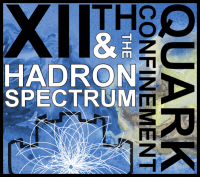Speaker
Description
A novel approach to identify the geometrical (anti)clusters formed by the Polyakov loops of the same sign and to study their properties in the lattice SU(2) gluodynamics is developed. The (anti)cluster size distributions are analyzed for the lattice coupling constant $\beta$=[2.3115; 3]. The found distributions are similar to the ones existing in 2- and 3-dimensional Ising systems [1]. Using the suggested approach, we explain
the phase transition in SU(2) gluodynamics at $\beta=2.52$ as a transition between two liquids during which one of the liquid droplets (the largest cluster of a certain Polyakov loop sign) experiences a condensation, while another droplet (the next to the largest cluster of opposite Polyakov loop sign) evaporates. The clusters of smaller sizes form two accompanying gases, which behave oppositely to their liquids. The liquid drop formula is used to analyze the distributions of the gas (anti)clusters and to determine their bulk, surface and topological parts of free energy. Surprisingly, even the monomer multiplicities are reproduced with high quality within such an approach. The behavior of surface tension of gaseous (anti)clusters is studied. It is shown that this quantity can serve as an order parameter of the deconfinement phase transition in SU(2) gluodynamics. Moreover, the critical exponent $\beta$ of surface tension coefficient of gaseous clusters is found in the upper vicinity of critical temperature. Its value coincides with the one found for 3-dimensional Ising model within error bars. The Fisher topological exponent
$\tau$ of (anti)clusters is found to have the same value 1.806 $\pm$ 0.008, which agrees with an exactly solvable model of the nuclear liquid-gas phase transition [2] and disagrees with the Fisher droplet model [3], which may evidence for the fact that the SU(2) gluodynamics and the model [2] are in the same universality class.
[1] L. Moretto et al., Phys. Rev. Lett. 94, 202701 (2005).
[2] V. Sagun, A. Ivanytskyi, K. Bugaev and I. Mishustin, Nucl. Phys. A 924, 24 (2014).
[3] M. E. Fisher, Physics 3, 255 (1967).




